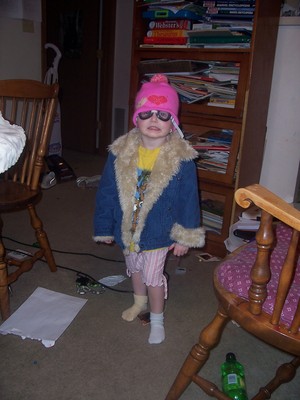Though I had given birth twice before this new little baby astounded me and threw me for a loop. At just minutes old she was just a bit different and I could not put my finger on it. I called a lactation that was on call in the hospital and asked them why the baby would not eat when I was touching her, and they comforted me with, “It is the hold she doesn’t like” and all I needed to do was switch to a “football style” or perhaps a “cradle style.” Being a third time mother they assumed I knew all these funny little words but in reality I just did what came naturally with the first two, and somehow this seemed as unnatural as could be. She seemed stressed by my comforting snuggles and caresses to her little feet. Eventually as I lay there with her I realized it was me touching her that she didn’t like. I put my hands in the air and had her lay across the pillow facing away from my body with my breast ever so lightly dangling into her hungry mouth and she would finally eat. For four weeks we did this little dance to get her to eat. When she was finished I had to lift her using the pillow or she would go into a fit of rage that I could not comfort. At the end of four weeks I had decided to give up the stress and start to bottle feed.
Now I had some new issues because you hold a baby and look at them when you feed them from a bottle, but with her she didn’t like that. If anyone made noises in the room she was in she would refuse to eat. I had to resort to sitting her up in her car seat and turning the lights off and sitting outside the door listening to her eat. I had the hardest time explaining to people that she was a high needs baby because she always seemed content sitting in her car seat. She looked so sweet sitting there looking around. When people think of high needs they think of constantly running and coddling and constant crying or other troublesome problems. I had a baby that needed me to let her be.
When she turned a year old she had still not made twice her birth weight when the doctors wanted her to be at three times her birth weight in that time. My little 7 lb 10 oz package wasn’t even 15 lbs on her first birthday and we new that she needed to start to eat more calories and start solids because she had learned to walk early and climbed everywhere. She seemed to burn everything she ate really fast and was always in motion touching stuff, climbing on stuff, and otherwise trying to process her surroundings. Our new challenge was to get her to eat things other than her formula. After much trial and error we figured that she would not eat anything that had a soft texture and were reduced to feeding her raw foods that she could shred with her teeth.
Carrots and celery were her favorites. Shorty after her first birthday we could not get her to wake up for more than a minute or two and were forced to take her to the emergency room to see what was the matter with her. They decided to admit her and see if they could sort it all out. They found that she had an unusually high salt and low sugar count, but she was not diabetic. After sitting in the hospital holding my child, her wanting my comfort was my first clue she was really not well, they decided that I just needed to always make sure that she had sugar and salt in about the same portions so that she could remain balanced and not fall into a coma again. I was not going to argue or press to find a better answer as I was pretty far along in my pregnancy with my next child and I really wanted to go home after a week in a hospital. It was about then that she started to crave a bit more sensory input like deep pressure.
Her active little self would seem to crave the most dangerous activities and the only time that she was actually in danger, it seemed, was when I was trying to save her. When I saw my not quite two year old, that was no bigger than a pixie, skateboarding I knew that I had to leave her be. She did it as if she had been practicing forever but if I tried to go over to her to help she would flail and fall. Again I had to sit on the sidelines and watch. I watched as my 3 year old climbed on top of a swing set and held my breath as I patiently waited under her for her to get down. The other parents talking behind my back and not understanding my methods were of no concern to me as I knew if I helped, or tried to, she would go into a fit of rage that would last for hours, possibly even days.
Her sleeping habits would keep me awake most nights as she would fight for hours and hours. Every night we tried to do the same thing so she would know what was coming up and eventually learn to just sleep. Some nights though she craved more sensory input and we had to brush her body or turn the volume all the way up on the television. Every night, no matter what, she had to have a blanket that I owned that was now hers. Later we realized it was because of the weight the blanket had. No matter how many nights went by she would fight sleep with all her might. Most of the time that she did manage to sleep before 2 am she would still get up in the middle of the night and wander around. The gate that we used to attempt to keep her safely in her room became useless as she learned she could climb it. She could even get over the no climb gates that were taller than she was. I had to always be on guard so she did not leave the house.
When we were outside the house the challenges that we faced with noise levels and crowding were always in the back of my mind. Most days I could get in and out without problems because I learned her signals and I just knew when it was getting to be too much for her. To others, if we did not leave in time, she seemed like a child having a temper tantrum, but I knew that her “tantrum” was really her brain going into fight or flight mode. Her brain would either tell her to lash out and fight for her life or would send her into a deep black corner where we had a hard time finding her and bringing her back. Although I still had no name with what she “had” I knew she couldn’t be the only one out there. She couldn’t be the only little quirky one that was so high energy and such a dynamo. This little sprite could really wow you with her intelligence and was so agile she could do things kids twice her age couldn’t but for some reason her clothing had to be “just so” and the same outfit that she loved yesterday she couldn’t even look at the next day with out a fit of rage.
When she was four years old we made the mistake of taking her to the grocery store late in the evening instead of our normal slower afternoon. She was walking and started shivering, her nerves were going into overdrive and we heard this little soft voice say “These people are all evil, they are going to kill me.” We new that our shopping was going to have to wait and we did the best we could to make it straight up to buy what we had and leave before she totally lost herself. Up high on her father shoulders and with him petting on her legs she was able to keep it under control we quickly and quietly made it out. Our challenge with her is knowing when she needs more input, like deep tissue massage, or soft things like a brush lightly pressed against her skin, or to not have anything touching her at all. We need to know when she is needing time alone where there are no sounds or new sights to process so her brain can reset.
As she is getting older she is learning that she tends to “cycle” and will even tell you that is what she is doing when she tries to eat, but doesn’t want it, and then tries on 15 new shirts at the same time, then has to get them all off because one got a drop on it and she can’t be in the living room because it is blue… It’s a slow learning process, for her and us and through trial and error and watching her closely we have learned what she needs, even if it is not conventional, is what we need to do. We also learned this past year that she is our little quirky one, but there are also others out there and how she processes has a name. Sensory Integration Disorder is something she has and she is learning with us each day that it does not define her but it does help us understand her a bit more.





